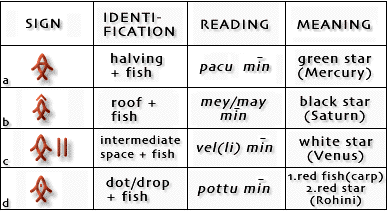The Star Rohini

Fig. 2: Modified Fish Signs
The Star Rohini
Parpola starts with the assumption that the 'dot + fish' sign (Fig.II d) occurring in the 'Fig Deity' seal is likely to represent the deity depicted on the seal identified by him as the goddess of fertility and victory in war, the Harappan proto-form of Durga. He asks himself which star is most likely to be associated with this goddess and decides, after a good deal of delving into Hindu mythology, that Rohini (Aldeberan) fits the context best. The association of Rohini (the 'red star') with the carp (rohita, 'the red fish') becomes the basis for identification of this sign as the carp also. Finally the mark inside the 'fish' sign is identified as the auspicious red tilaka mark worn by women on the forehead, which is equated with Dravidian pottu, '(red) dot, drop'. Hence the reading pottu min is interpreted as the 'carp' as well as the 'star Rohini'. The occurrence of pot (kike) in Gondi for 'Rohita fish' is pointed out as evidence in support of the reading.
However the expression pottu meen is not attested in Dravidian with the meaning 'star Rohini'. If *pottu meen means 'carp' in Central Dravidian languages, it must be on account of the dot-like scales rather than the red colour, as pottu does not mean 'red' in Dravidian. Similarly pottu, 'dot (on the forehead)' cannot by itself mean 'red' even if it is mostly red in colour. In short, Parpola interprets the words as 'red' by association and not by homonymy.
Quite apart from the linguistic problems pointed out above, Parpola's readings and interpretations of the 'modified fish' signs are, in general, insecure as they rest primarily on rather arbitrary meanings assigned to the conventional diacritic-like markings which cannot, by their very nature, be identified pictorially with any degree of certainty. Alternative interpretations are possible and have been proposed.
